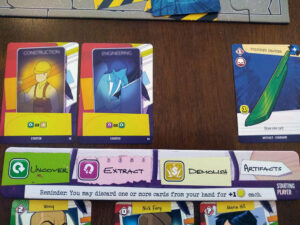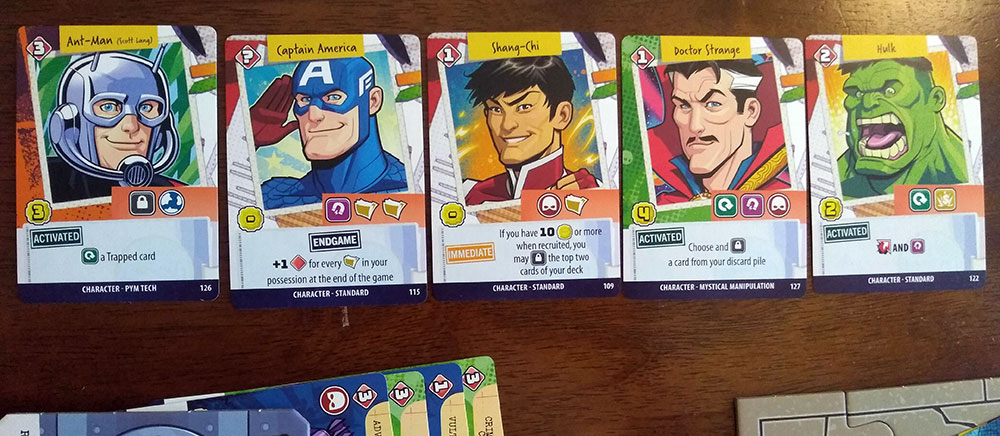 Several years ago, there were plans for a TV show set in the Marvel universe that focused on a construction company tasked with cleaning up the mess left behind when superheroes and supervillains battle through the city streets. The company, Damage Control, actually shows up in various Marvel comics, and it’s pretty interesting to think of what happens once the heroes save the Earth and move on, leaving behind a path of real-world destruction. The show never panned out, but Damage Control has shown up in a handful of Marvel movies and TV series since then. It’s not exactly the most well-known corner of the Marvel universe, but does it make for an intriguing concept for a board game? Or is this simply a low-quality game hoping to squeak by on its tacked-on theme? Stay tuned!
Several years ago, there were plans for a TV show set in the Marvel universe that focused on a construction company tasked with cleaning up the mess left behind when superheroes and supervillains battle through the city streets. The company, Damage Control, actually shows up in various Marvel comics, and it’s pretty interesting to think of what happens once the heroes save the Earth and move on, leaving behind a path of real-world destruction. The show never panned out, but Damage Control has shown up in a handful of Marvel movies and TV series since then. It’s not exactly the most well-known corner of the Marvel universe, but does it make for an intriguing concept for a board game? Or is this simply a low-quality game hoping to squeak by on its tacked-on theme? Stay tuned!
Marvel: Damage Control is a deck-building game for 1-4 players and plays in about 30 minutes.
Gameplay Overview:
In Damage Control, you’ll take on the role of one of the company’s construction managers, sifting through the rubble to find powerful artifacts and recruiting superheroes from the Marvel universe to aid in your efforts. The rubble is represented by a pile of facedown cards dropped onto the middle of the table, called the Destruction Zone. Some of these cards are flipped faceup and serve as the lineup available for growing your personal deck.

Each player starts with a few basic cards that can be used to carry out the main actions. You can Uncover cards in the rubble pile by flipping them faceup, but only if the radar symbol on the back of the card is fully visible. Extract allows you to pick up a faceup card and add it to your hand. To earn some cash, you can Demo a faceup card, removing it from the game and gaining 2 coins. Or you can use an action to place a card from your hand into your Vault, where it will remain out of play for the rest of the game. Artifact cards have victory point values, but can only be counted towards your final score if they’re in the Vault.
On your turn, you’ll have a hand of four cards that can be played to interact with the rubble in the Destruction Zone. After using a card for one of the actions printed on it, you’ll place it on the table in front of you, above your desktop, which has designated areas corresponding to the primary actions.
Once you’ve finished playing cards from your hand, you have an opportunity to recruit characters from the lineup. Once you’ve hired a character, you’ll place them below your desktop, with a limit of three at any given time. The character cards have various special abilities that can help you during the game or provide endgame scoring opportunities.
Players continue to take turns following the above structure until either the Destruction Zone is empty or there are no more cards left in the character deck. At the end of the game, players will add up the points on cards in their Vault and on their characters (including endgame-scoring abilities), with leftover coins providing a few points (three coins are worth a single VP).

Game Experience:
The most innovative aspect of Damage Control is the method of presenting the card offer. In place of a lineup or grid, the game has a cluttered pile of faceup and facedown cards. You spend actions rooting through the rubble and flipping over cards to see which artifacts are available. Rather than spend coins to purchase these cards, you’ll use an Extract action to pull them cost-free from the wreckage. While this is clearly meant to be a thematic twist on what many may find a dusty mechanism, the execution crumples like a building smashed by the Hulk.

First of all, creating and adding cards to the pile is clunky and haphazard. At setup, players must drop the cards into the Destruction Zone simultaneously from a height of 8 inches. Throughout the game, when certain events and abilities trigger the addition of more artifacts to the Zone, someone must take a card from the rubble deck and drop it faceup onto the heap. There’s no real mechanical reason for this procedure; the result is still just a randomized card offer. It feels more like an element of a dexterity or party game than that of a deck-builder.
What’s more, Damage Control has turned the replenishment of the “market” into a task for players to perform themselves using action cards. If you’re not satisfied with what’s on offer, you’ll need to use Uncover actions to flip cards over to see what can be extracted. While one might normally leap at the chance to have some agency related to card availability in a deck-builder, don’t put your cape on just yet. Through sheer luck, your turn might start off with just a few faceup cards visible, maybe even none. You only have four cards in hand, so it could be necessary to spend your limited actions merely turning over cards and hoping there’s something there worth extracting. Of course, you’re likely to be helping out an opponent by revealing some juicy artifacts with just the icons they need to recruit a character or score endgame points, just as you runout of actions yourself. And the arbitrary uncover rules, which forbid you from turning over a card unless its radar symbol is fully visible, don’t serve any purpose. You have no idea what these facedown cards are, so there’s no reason to want to flip over any particular one. You must try and replace the newly faceup card exactly where it originally lay, which again leans more into some sort of dexterity-based gameplay than is necessary.

Even worse, though, is that flipping a card will trigger a random event, which very well could nuke your plans for the entire turn. Say, perhaps, that you are playing cards to acquire the symbols needed to recruit Scarlet Witch, who has an endgame scoring condition that fits perfectly with the cards you happen to have accumulated. You have to play some Uncover action cards to meet her requirement, but they both reveal Character Sighting events. This adds two new characters to the lineup, pushing Scarlet Witch into the discard pile and out of your reach. This random turn of events probably lost you the game, without offering you any way to mitigate the outcome.
There are also a lot of “take that” cards and events that will whittle away your meager hand size of four cards. Imagine how exciting it is to start your turn with one card in hand and no faceup artifacts in the Destruction Zone. Deck-building games always have to contend with the effects of random card draws; you’re often not drawing your combo cards together or you’re getting hit by attacks from other players or you end up hosed on the market options. But where other, stronger deck builders incorporate elements to mitigate the impact of randomness, Damage Control really just feels like a hectic exercise in frustration. Particularly at higher player counts, you’ll probably sense that there’s no control over your fate and any semblance of strategy is likely to go out the window a few turns into the game.

Another mechanical weakness is that extracting cards from the Destruction Zone is a low-cost effort. That is, all cards have the same “cost” of needing a single Extract action to remove them from the rubble. In most deck builders, cards with strong effects or high point values will generally be more expensive to acquire from the market. In Marvel: Damage Control, a 5-point artifact is just as easy to pull out as a 0-point one is, so there’s really no impetus to build your deck to excel at producing resources to acquire valuable cards in this game. It’s almost purely a set collection game, rather than a deck builder. There aren’t any combos to pull off in Damage Control, so you won’t be striving to acquire cards because they synergize with one another. I suppose you won’t have to worry much about not being able to get your card combos to come up in the same hand, but then again, a lot of the excitement of a deck builder lies in constructing a deck that can do cool things. You won’t be doing that here.
There’s very little variation in the game, which is in large part due to the dearth of genuine action options among the cards. You’re just pulling cards out of the rubble and playing them to pull more cards out of the rubble. The game appears to be pushing you to believe that there should be a tough choice between leaving a card in your deck so you can continue taking advantage of its abilities or placing it into the Vault so that it can be scored at the end of the game. But the artifact cards don’t really do anything more than your basic starter cards, and they generally cost coins to even play, which means you’ll need to be generating coins to keep making use of them. You’re probably better off just dumping artifacts into the Vault every turn possible, because those are cold hard points and the abilities don’t really do much anyway. So the question becomes, what’s the point of it all anyway?
Final Thoughts:
Marvel: Damage Control unfortunately doesn’t add anything to the deck building genre; indeed, it’s severely lacking in most of the areas that make such games fun to play. The main thematic conceit, that you’re digging through rubble to find valuable artifacts to lock into your vault, doesn’t translate to a solid mechanical framework. There’s no dynamism to the gameplay, no real sense of building a powerful deck, and far too much chaos. What seems to be a central strategic element, the choice of when to secure an artifact into your Vault for final scoring, is an illusion of complexity. Even the most diehard Marvel fans, whom this game clearly wants to lure in, are likely to be left disappointed by the absence of compelling choices, and even fun.
Final Score: 1.5 Stars – Slapped on IP cannot mask weak gameplay.
Misses:
• You’re not building a fun, powerful deck
• Rubble mechanism is clunky
• Theme is pasted on
• Too much random chaos






















